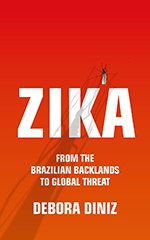Reviewed Book
Zika: From the Brazilian Backlands to Global Threat. Deborah Diniz, translated by Diane Groskalus Whitty, London: Zed Books, 2016, 192 pp.

Deborah Diniz’s Zika: From the Brazilian Backlands to Global Threat illustrates the trajectory of the Zika virus through the eyes of the women who most suffered in the epidemic. This perspective allows for a compelling and captivating book that contributes to understanding the human dimension of the epidemic in Northeastern Brazil, an area plagued both by the Aedes aegypti mosquito—the Zika virus vector—and by extreme social inequality. Diniz’s book illustrates that the morbidity of Zika goes beyond a fever or a congenital disability. Acquiring Zika during pregnancy can become an emotional and mentally painful experience as well, filled with unsurmountable obstacles and unknown solutions. By giving women an outlet to voice their experiences, concerns, and pain, and in so doing capturing the challenges of pregnancy and motherhood in Brazil, Diniz humanizes the Zika as it hasn’t been thus far.
Diniz discusses the scientific timeline of the epidemic as it unfolded in Brazil and the social context in which it thrived. She illustrates how the science of the virus cannot be fully understood until we examine how economic and social inequality—and, at times, research itself—exacerbated the epidemic and its associated suffering. While several publications have discussed ethical considerations for conducting research during an ongoing epidemic, this book allows the reader to understand how research can contribute to the exploitation of pain when the women and their children being studied become mere case numbers and blood samples who now suffer the stigma of being labeled as “a Zika case” or “a microcephaly case.” Diniz highlights numerous ethical concerns, which act as reminders to the scientific community that our actions are neither justified nor minimized by our contributions to science and that we need to remain mindful of the power and impact of our research questions and scope as we enter a community, mainly when their lives are vulnerable and their rights have been threatened.
Diniz also reminds us that research initiatives should not forget the children and grieving mothers whose blood samples and cases fill journals. For those hoping to lessen the pain of the epidemic, Diniz compellingly argues that the next step should be to focus on increasing the amount of available and adequate care for the women and children who have been, paradoxically, both put under a microscope and forgotten by their country and health care system.
In the book, Diniz also gives space for northeastern Brazilian researchers and physicians to voice their struggles. While the women being studied were trapped in social and economic hardship, their fellow Brazilian physicians and researchers were stuck in a two-fold intellectual hierarchy—scrutinized at both the international and country levels—limiting the credibility of their work and discoveries. As the global community looked on, it was wary of Brazilians’ ability to adequately evaluate and contain the virus. Inside Brazil, there was skepticism of the capability of northeastern Brazilian physicians and researchers to understand the conditions flooding their offices. Diniz describes the criticism these professionals experienced, as more affluent southern research institutions within Brazil disparaged their procedures, methods, and facilities, as well as their ability to achieve breakthroughs and success.
As the third year of the epidemic begins to unfold, Zika: From the Brazilian Backlands to Global Threat can serve as a tool for reflection for researchers and public health agencies. The Zika epidemic has been flooded with quantitative analysis, case study reports, and a race for a vaccine. Little work has been done to capture the voices and viewpoints of the women at its epicenter. Diniz’s book does just that. As Diniz highlights, the catalysts for the transmission of both the Zika virus and the exacerbation of pain were social inequality and fractures within the health care infrastructure. Diniz convinces us that we can no longer forget impoverished areas of any country, for such forgetting can lead to vast morbidity and global threats.
With urbanization, global warming, and deforestation increasing by the day, the next emerging infectious disease is on the horizon. Diniz’s book may serve as a lesson to be learned from the Zika epidemic: that science must not forget the human side of a viral epidemic and that progress toward a cure needs to be conducted in solidarity with care.